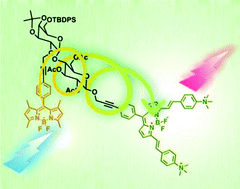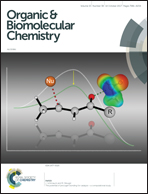Synthesis and photophysical properties of a bichromophoric system hosting a disaccharide spacer†
Abstract
The synthesis of an efficient energy donor–acceptor system is reported, together with its photophysical properties. The bichromophoric species has been conceived to show potentialities for biological applications since a biocompatible disaccharide spacer, constituted of D-galactose and D-glucose derivatives, was used in compound 12 to connect two BODIPY units with different absorption/emission properties. The luminescence spectrum in acetonitrile of 12 shows an intense fluorescence band with a maximum at about 770 nm that is almost identical to that of the lowest-energy BODIPY, regardless of the excitation wavelength used. The quantum yield is 0.2 with an excited state lifetime of 2.5 ns. Excitation and ultrafast transient absorption spectroscopy demonstrates that a very efficient energy transfer takes place in 12 from the highest-energy lying BODIPY subunit to the lowest-energy emissive BODIPY moiety, with a time constant of about 31 ps. Noteworthily, the emission of 12 falls in the near infrared window, suitable for potential biological applications.



 Please wait while we load your content...
Please wait while we load your content...